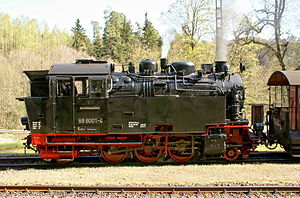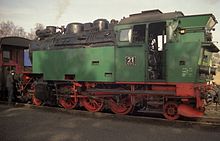NWE No. 21
| NWE No. 21 series 99.600 |
|
|---|---|
|
99 6001 in Mägdesprung (2012)
|
|
| Numbering: | NWE No. 21 II DR 99 6001 |
| Number: | 1 |
| Manufacturer: | Krupp food |
| Year of construction (s): | 1939 |
| Type : | 1'C1 'h2t |
| Genre : | K 35.10 |
| Gauge : | 1000 mm ( meter gauge ) |
| Length over buffers: | 8,875 mm |
| Height: | 3,650 mm |
| Width: | 2,600 mm |
| Fixed wheelbase: | 2,400 mm |
| Total wheelbase: | 6,060 mm |
| Smallest bef. Radius: | 40 m |
| Empty mass: | 37.84 t |
| Service mass: | 47.58 t |
| Friction mass: | 30 t |
| Top speed: | 50 km / h |
| Indexed performance : | 400 kW (540 PS) |
| Starting tractive effort: | 72.6 kN |
| Driving wheel diameter: | 1,000 mm |
| Impeller diameter: | 600 mm |
| Control type : | Heusinger |
| Number of cylinders: | 2 |
| Cylinder diameter: | 420 mm |
| Piston stroke: | 500 mm |
| Boiler overpressure: | 14 bar, 1.4 MPa |
| Number of heating pipes: | 108 |
| Number of smoke tubes: | 32 |
| Grate area: | 1.56 m² |
| Radiant heating surface: | 7.36 m² |
| Superheater area : | 25.2 m² |
| Evaporation heating surface: | 72.00 m² |
| Water supply: | 5 m³ |
| Fuel supply: | 2 t |
| Locomotive brake: | Knorr m. Z. |
| Coupling type: | Balance lever coupling |
The . NWE # 21 II , later, 99 6001 , is built in 1939 Vineyard - steam locomotive for 1.000 mm gauge , which in today Harz narrow gauge railways is (HSB) in use.
history
The locomotive is the only built example of a projected series of standardized superheated steam locomotives with the axle sequences 1'C1 ', 1'D1' and 1'E1 ', which the Nordhausen-Wernigeroder Eisenbahn-Gesellschaft (NWE), the Gernrode-Harzgeroder Eisenbahn- society and the South Harz Railway company at the company locomotive and waggon Krupp had been commissioned to replace older, less economical wet steam locomotives. As a result of the standardization, as many parts of the machines as possible should be usable across series in the interest of cost-effective production, simplified spare parts stocking and easier maintenance and maintenance of the locomotives. However, since the development contract was not carried out by the Deutsche Reichsbahn and partly deviating building principles were applied, it is still not a standard locomotive in common usage. Due to the outbreak of the Second World War , however, only the preserved prototype of the 1'C1 'type was built by Krupp in 1939, and the orders for further machines were canceled.
The prototype locomotive was taken over by the NWE under the number 21 II and after the takeover of the NWE by the Deutsche Reichsbahn in 1949 it was renamed 99 6001 . In 1970 the locomotive was given the computer number 99 6001-4 .
In 1956, the machine was initially relocated from the Harzquerbahn to the Selketalbahn , at least temporarily , and then continuously from 1961. It pulled the first scheduled passenger train between Gernrode via Stiege to Hasselfelde on June 3, 1984 and since the reopening of the connecting line has also been in use again on the Harzquerbahn.
Between 1991 and 1994, it was in green color and with a 21 as the locomotive number in service for a short time in front of the traditional train , a special train made up of historic wagons, as the Mallet locomotives could not be adapted to the new air brakes of the wagons. In addition, outside of the special train services, she performed her duty from the Gernrode deployment site.
In the years 2012 to 2014 the locomotive received a new boiler and a general inspection at the Meiningen steam locomotive works .
technical features
In the design and construction of the NWE 21 II , Krupp made extensive use of welding, including the boiler, in contrast to the state of the art of the Reichsbahn standard locomotives at the time.
The three driven wheel sets are firmly mounted in a bar frame with 70 mm cheek thickness. The two leading and trailing wheel sets are each mounted in a Bissel frame so that they can be swiveled out radially .
The boiler is fed by two steam jet pumps .
The two external cylinders of the steam engine, which are slightly inclined due to the restrictions of the clearance profile, are controlled by a Heusinger control with a Kuhn loop . The Schulz type piston valves that were initially installed were later replaced with Trofimoff piston valves . These offer a better idling behavior of the locomotive when the regulator is closed, as they practically cancel the work of the cylinder as an air pump that occurs in and of itself when the steam pressure ceases.
Together with the class 99.32 locomotives, which are also approved for 50 km / h , the locomotive is one of the five narrow-gauge steam locomotives with the highest top speed in Germany.
literature
- Horst J. Obermayer: Paperback German narrow-gauge steam locomotives . Franckh, Stuttgart 1971, ISBN 3-440-03818-1 .
- Hans Röper, Helmut Becker, Werner Dill, Gerhard Zieglgänsberger: The Harzquer and Brocken Railway. 3rd, extended edition, Transpress Verlagsgesellschaft, Berlin 1992 ISBN 3-344-70747-7 .
- Manfred Weisbrod, Hans Wiegard, Hans Müller, Wolfgang Petznick: German Locomotive Archive: Steam Locomotives 4 (Class 99) . transpress, Berlin 1995, ISBN 3-344-70903-8 , p. 233 ff.


